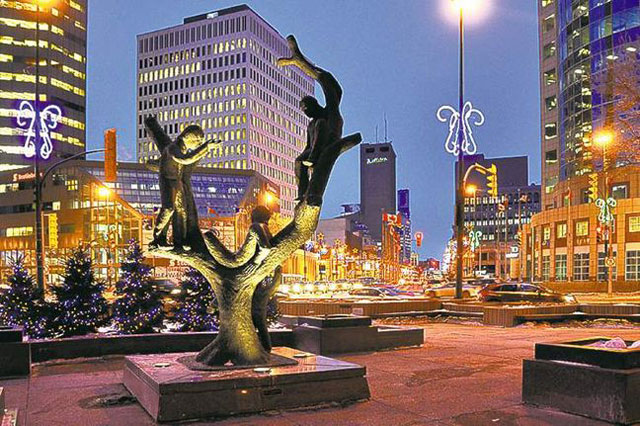Ask any Winnipegger what their favourite piece of public art is and the response will likely be a confused look and the question, "Winnipeg has public art?"
Ours is an artistic community. With only two per cent of Canada's population, we have 12 per cent of its musicians. We have the country's oldest civic art gallery, French-language theatre, English regional theatre and dance company. We are home to a renowned symphony and numerous artistic festivals. Despite this creative heritage, we have fallen behind other major Canadian cities in our funding for and implementation of great public art.

North American cities today are turning to public art as a means of defining and enhancing urban identity and character. The visual appeal of a community can play a significant role in cultivating civic pride and emotional attachment from the people who live in them. It is human character to seek out physical beauty in the things that surround us and in the places we live. Public art that is authentic, stimulating and visually appealing can contribute to this sense of public well-being. Although not plentiful, Winnipeg does have some inspiring examples of urban art that illustrate the benefits of this type of economic investment in our communities.
Effective public art can help to articulate a shared sense of place and belonging within a city or neighbourhood. It can celebrate cultural diversity and unite social groups, expressing the history, traditions and identities unique to that community.
A brilliant example of an installation that accomplishes these goals is the Oodena Circle at The Forks. Eight rusted steel armatures that relate to wind, sun and the stars rise into the sky, defining the spatial boundaries of the plaza and acknowledging its cultural history. The site has been embraced by aboriginal people as a place of celebration, bringing the city's cultural groups together, elevating social awareness and fostering an emotional connection to each other and to the city.
An installation of 38 interactive light posts on a sloped piece of land in Central Park, called DIY Field, exemplifies how great public art can unite and rejuvenate a community. Once a crime-filled urban space, Central Park is now the pride of a growing and vibrant immigrant neighbourhood in downtown Winnipeg. Any evening, in any season, children can be seen running through the grid of posts excitedly changing the coloured lights as they pass through. The art activates the park in the evenings, improving safety and contributing to a renewed sense of public ownership that has allowed it to become a cultural and social focal point in the neighbourhood.
On an urban scale, public art can improve civic identity, helping to redefine a city's image, locally and abroad. The Old Market Square Cube Stage and Esplanade Riel Bridge serve as two examples of functional civic infrastructure that elevate themselves through creative design to iconic pieces of public art. Both have come to symbolize Winnipeg as a place of imagination and creativity, celebrating a new wave of architectural and artistic development that has begun to redefine our civic image abroad.
Public art can have educational value, such as the inscribed artwork on the guardrails of the new Osborne Bridge telling the history of the area. It can also simply be a fanciful urban landmark that transforms a public space into a public place. As an example, at the Millennium Library, a new 10-metre-high stainless steel sculpture in the shape of a container draws attention and gives definition to a newly renovated urban plaza that has long been forgotten behind the walls of the library's parkade.
Recognizing all of these intrinsic benefits, in 2004 then-mayor Glen Murray established Winnipeg's Public Art Program.
Managed by the Winnipeg Arts Council, the program is funded by a yearly capital grant from the City of Winnipeg that is subject to the annual budget-approval process.
In cities such as Calgary, Edmonton and Ottawa, public arts funding is not a line item in the civic budget, but is tied to development growth in a strategy called 'per cent for art.'
For every infrastructure project financed by the civic government, including roads, sewers and buildings, one per cent of the construction cost is put aside to finance public art.
This funding model has resulted in a greater level of arts investment in Winnipeg's rival cities. In Toronto, the percentage for art model is expanded to include private development. Engaging the corporate sector has resulted in per capita arts funding that is five times higher than in Winnipeg and has cemented Toronto's reputation as a culturally rich city.
Somewhat lost in the inhospitable pedestrian environment of Portage and Main, three stunning bronze sculptures at the base of the Richardson Building stand as examples of what can be achieved in our own city when the corporate sector is engaged.
Winnipeg's rivals all recognize the value of public art as an investment that contributes to the establishment of a vibrant, beautiful and creative urban environment that will be attractive to those economic drivers.
Working to align our public arts funding from government and corporate sources with that of other Canadian cities would strengthen our artistic community and enhance our already impressive set of cultural assets, ensuring Winnipeg remains artistically vibrant and economically competitive in today's creative economy.
Growing our collection of urban art would inject an element of warmth and lively artistic expression into our monochromatic northern city, to be celebrated even during the coldest and darkest days of the year.
Brent Bellamy is senior design architect for Number Ten Architectural Group.
Republished from the Winnipeg Free Press print edition December 3, 2012 B5

